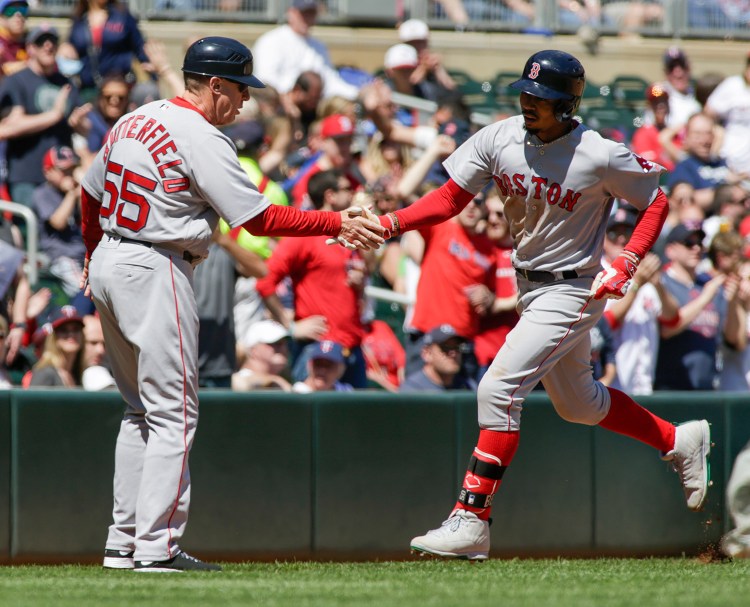In baseball, as in life, the answers to questions that are plaguing you usually come from within.
So it was with the Red Sox offense over the weekend. Scuffling to put together runs and struggling against the very hittable Phil Hughes on Friday night, the Sox needed help getting more production from the lineup.
So Manager John Farrell and bench coach Gary DiSarcina put their heads together and shuffled the batting order from top to bottom. The result was a Saturday lineup that had only one hitter in the same spot as Friday night. Mitch Moreland stayed in the sixth spot, but everything else changed.
The result was an eight-run second inning, the biggest inning of the season for the Red Sox. They bested that a day later with a 10-run ninth inning and a season-high 17 runs against the Twins.
For some Red Sox hitters, the reshuffling was a return to places where they were very much accustomed. Mookie Betts found himself leading off, which is where he hit in 109 games last season. During the offseason, I asked Betts where he envisioned himself in the lineup, and he didn’t miss a beat when he answered “leading off.”
Dustin Pedroia had been leading off most of this season. After Betts hit 31 homers and finished second in the American League MVP voting, he was looked at as a No. 3 or No. 4 batter. So Pedroia, a prototypical No. 2 hitter, had found himself at the top of the order.
The biggest surprise in the lineup shuffle was Andrew Benintendi’s move to the cleanup spot. At 5-foot-9 and 180 pounds, Benintendi is not your typical No. 4 hitter. Yet he hit his fifth home run of the season Sunday, moving him into tie with Hanley Ramirez for most on the team.
In fact, Boston’s first six runs Sunday came via the long ball. The Red Sox have hit 17 homers in the last 13 games after hitting 10 in their first 18 games. It feels similar to last year, when Boston was last in the American League in homers in April but finished with a very respectable 208 home runs.
The Red Sox were last in homers this April, too, not just in the AL, but in the majors. They haven’t suddenly found their power because of the new lineup, but there’s no denying the fact that 28 runs in two games shows that changing the order has had a positive effect. It was the first time this season the Red Sox scored six or more runs in back-to-back games.
“We’re just trying to put together a combination here that we can take advantage of stringing some hits together,” Farrell told reporters Saturday in Minneapolis. “That hasn’t been the case in many of the games thus far.”
It worked for two games in Minnesota. We’ll see what happens beginning Tuesday night in Milwaukee when the Red Sox play the Brewers under interleague rules, with the pitcher forced to hit.
Farrell has taken his fair share of criticism from Boston media and fans in recent years. They are quick to point out any mistake he might make and are quicker to lay the blame for any loss. So it’s only fair to give him credit for a move that paid off in a couple wins. The offense was looking for answers to its early season lack of power and has found it at the start of this trip.
Those answers came from the manager, who felt he could find the solution from the players he had on the roster. This team entered the season expecting to come close to the league-leading 878 runs scored. While the Red Sox have hit for average, they have not consistently turned that into run production.
The newly constructed lineup did on both Saturday and Sunday. We’ll see if that’s the spark that will ignite the offense in the weeks to come.
Tom Caron is a studio host for the Red Sox broadcast on NESN. His column appears in the Portland Press Herald on Tuesdays.
Send questions/comments to the editors.



Comments are no longer available on this story